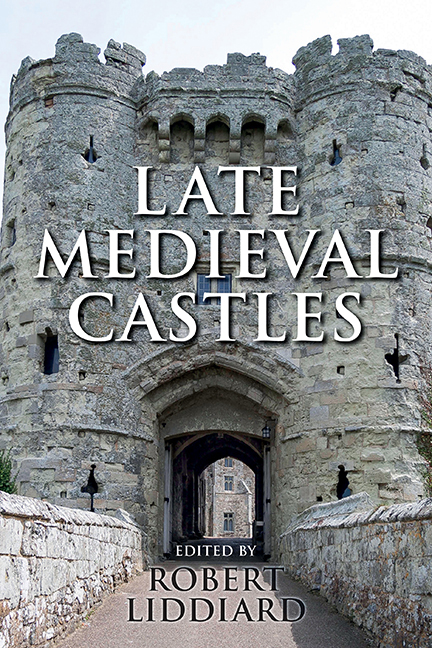Book contents
- Frontmatter
- Contents
- List of Illustrations
- Acknowledgements
- Editor's Preface
- List of Abbreviations
- A Note on the Text
- Introduction
- 1 Fourteenth-Century Castles in Context: Apotheosis or Decline?
- 2 Architects, Advisors and Design at Edward I's Castles in Wales
- 3 The Courtyard and the Tower: Contexts and Symbols in the Development of Late Medieval Great Houses
- 4 Castle Planning in the Fourteenth Century
- 5 Meaningful Constructions: Spatial and Functional Analysis of Medieval Buildings
- 6 Mota, Aula et Turris: The Manor-Houses of the Anglo-Scottish Border
- 7 Lulworth Castle, Dorset
- 8 A Scottish Problem with Castles
- 9 Structural Symbolism in Medieval Castle Architecture
- 10 Specimens of Freedom to Crenellate by Licence
- 11 Some Analysis of the Castle of Bodiam, East Sussex
- 12 English Castles in the Reign Of Edward II
- 13 Castles of Ward and the Changing Pattern of Border Conflict in Ireland
- 14 The Donjon Of Knaresborough: The Castle As Theatre
- 15 The Architecture of Arthurian Enthusiasm: Castle Symbolism in the Reigns of Edward I and his Successors
- 16 Medieval Ornamental Landscapes
- 17 Otherworld Castles in Middle English Arthurian Romance
- Guide to Further Reading
- Index
12 - English Castles in the Reign Of Edward II
Published online by Cambridge University Press: 29 April 2017
- Frontmatter
- Contents
- List of Illustrations
- Acknowledgements
- Editor's Preface
- List of Abbreviations
- A Note on the Text
- Introduction
- 1 Fourteenth-Century Castles in Context: Apotheosis or Decline?
- 2 Architects, Advisors and Design at Edward I's Castles in Wales
- 3 The Courtyard and the Tower: Contexts and Symbols in the Development of Late Medieval Great Houses
- 4 Castle Planning in the Fourteenth Century
- 5 Meaningful Constructions: Spatial and Functional Analysis of Medieval Buildings
- 6 Mota, Aula et Turris: The Manor-Houses of the Anglo-Scottish Border
- 7 Lulworth Castle, Dorset
- 8 A Scottish Problem with Castles
- 9 Structural Symbolism in Medieval Castle Architecture
- 10 Specimens of Freedom to Crenellate by Licence
- 11 Some Analysis of the Castle of Bodiam, East Sussex
- 12 English Castles in the Reign Of Edward II
- 13 Castles of Ward and the Changing Pattern of Border Conflict in Ireland
- 14 The Donjon Of Knaresborough: The Castle As Theatre
- 15 The Architecture of Arthurian Enthusiasm: Castle Symbolism in the Reigns of Edward I and his Successors
- 16 Medieval Ornamental Landscapes
- 17 Otherworld Castles in Middle English Arthurian Romance
- Guide to Further Reading
- Index
Summary
Why did castles not play a more dominant role in the troubles of Edward II's reign? There were no major sieges like those of Bedford or Kenilworth in the thirteenth century, and castles failed to protect the north against Scottish raids. It was not so much that their walls and battlements were inadequate, but rather that garrisons and supplies were often insufficient. Frequent changes of command partly reflected the political difficulties of the period, but were also a result of administrative confusion. In several English towns there was considerable trouble between the constable of the local castle and the urban populace. Royal attempts to overawe opposition by placing large numbers of castles in a state of defence seem to have had little effect, while baronial castles rarely held out for long under attack. Architectural developments reflected the changing role of castles. The traditions of Edward I's castle-building declined, and there was a greater emphasis on the domestic aspects of castles, rather than on the fortifications. Much building was on a relatively small scale, in response to local disorder rather than national emergency.
It was not very often that the castles of medieval England were put to the test. The reign of Edward II, however, witnessed both civil war and invasion by the Scots, and it is striking that castles did not play the dominant role that they had a century previously. The warfare at the end of John's reign and in Henry III's minority had largely centred on castles. Sieges such as those of Rochester, Dover and Bedford were important turning points. Later, in the mid-thirteenth century, the protracted defence of Kenilworth in the final stages of the Barons’ Wars amply demonstrated the efficacy of strong defences against a massive mobilisation of resources. Yet under Edward II, sieges were usually very brief, as when the king's favourite, Piers Gaveston, surrendered at Scarborough in 1312, or when the king took Leeds in Kent in 1321. Thomas of Lancaster's supporters in 1322 did not attempt to hold out behind strong walls as Simon de Montfort's had done in 1266. Nor, apparently, did castles do much to deter the Scots on their frequent and highly profitable raids into the north of England. Yet although the military importance of castles appears to have declined by the early fourteenth century, questions regarding their custody were politically significant.
- Type
- Chapter
- Information
- Late Medieval Castles , pp. 303 - 322Publisher: Boydell & BrewerPrint publication year: 2016



